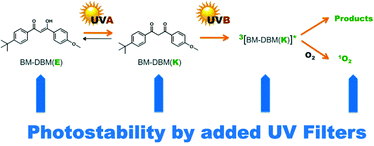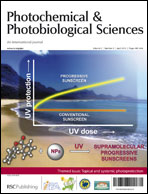In most sunscreens, the presence of two UV filters usually leads to synergistic effects regarding both the final performance and photostabilization of the active principles. However, this may also result in an accelerated decomposition if a photoreaction occurs between the single components. Thus, the understanding of photophysics and photochemistry of UV filter combinations is important to improve sunscreen photostability. In this context, photoreactivity of a commonly used UVA filter, namely tert-butylmethoxydibenzoylmethane (BM-DBM, also known as avobenzone, Parsol 1789, etc.), has been studied in the presence of six commercial solar filters: octyl methoxycinnamate, bis-ethylhexyloxyphenol methoxyphenyl triazine, octocrylene, diethylamino hydroxybenzoyl hexyl benzoate, octyl triazone and dioctyl butamido triazone. To achieve this goal, a mechanism-based strategy has been designed in order to investigate the photostability of sunscreens in a more systematic way, taking into account different processes: tautomerization of BM-DBM, formation of triplet excited state of BM-DBM in its diketo form and its quenching in the presence of UV filters, reactivity of UV filters under triplet photosensitization, quenching of singlet oxygen by UV filters and degradation of the latter under singlet oxygenation conditions.


 Please wait while we load your content...
Please wait while we load your content...